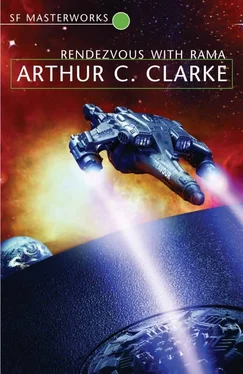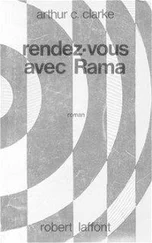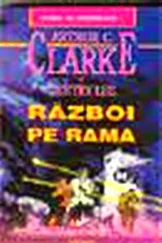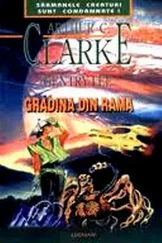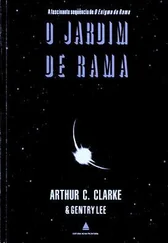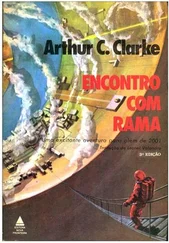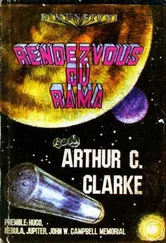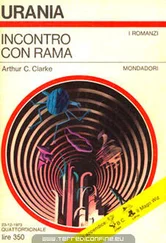He was still queasily brooding over this problem when the momentum damper at the end of the line braked him gently to a halt, with a barely perceptible rebound. He swept the vainly-probing beam of the flashlight down from the nothingness ahead, to examine the surface from which he had emerged.
He might have been hovering over the centre of a small crater, which was itself a dimple in the base of a much larger one. On either side rose a complex of terraces and ramps—all geometrically precise and obviously artificial—which extended for as far as the beam could reach. About a hundred metres away he could see the exit of the other two airlock systems, identical with this one.
And that was all. There was nothing particularly exotic or alien about the scene: in fact, it bore a considerable resemblance to an abandoned mine. Norton felt a vague sense of disappointment; after all this effort, there should have been some dramatic, even transcendental revelation. Then he reminded himself that he could see only a couple of hundred metres. The darkness beyond his field of view might yet contain more wonders than he cared to face.
He reported briefly to his anxiously-waiting companions, then added: “I’m sending out the flare—two minutes delay. Here goes.”
With all his strength, he threw the little cylinder straight upwards—or outwards—and started to count seconds as it dwindled along the beam. Before he had reached the quarter minute it was out of sight; when he had got to a hundred he shielded his eyes and aimed the camera. He had always been good at estimating time; he was only two seconds off when the world exploded with light. And this time there was no cause for disappointment.
Even the millions of candlepower of the flare could not light up the whole of this enormous cavity, but now he could see enough to grasp its plan and appreciate its titanic scale. He was at one end of a hollow cylinder at least ten kilometres wide, and of indefinite length. From his viewpoint at the central axis he could see such a mass of detail on the curving walls surrounding him that his mind could not absorb more than a minute fraction of it; he was looking at the landscape of an entire world by a single flash of lightning, and he tried by a deliberate effort of will to freeze the image in his mind.
All round him, the terraced slopes of the “crater” rose up until they merged into the solid wall that rimmed the sky. No—that impression was false; he must discard the instincts both of earth and of space, and reorient himself to a new system of coordinates.
He was not at the lowest point of this strange, inside-out world, but the highest. From here, all directions were down, not up. If he moved away from this central axis, towards the curving wall which he must no longer think of as a wall, gravity would steadily increase. When he reached the inside surface of the cylinder, he could stand upright on it at any point, feet towards the stars and head towards the centre of the spinning drum. The concept was familiar enough; since the earliest dawn of space flight, centrifugal force had been used to simulate gravity. It was only the scale of this application which was so overwhelming, so shocking. The largest of all space stations, Syncsat Five, was less than two hundred metres in diameter. It would take some little while to grow accustomed to one a hundred times that size.
The tube of landscape which enclosed him was mottled with areas of light and shade that could have been forests, fields, frozen lakes or towns; the distance, and the fading illumination of the flare, made identification impossible. Narrow lines that could be highways, canals, or well-trained rivers formed a faintly visible geometrical network; and far along the cylinder, at the very limit of vision, was a band of deeper darkness. It formed a complete circle, ringing the interior of this world, and Norton suddenly recalled the myth of Oceanus, the sea which, the ancients believed, surrounded the Earth.
Here, perhaps, was an even stranger sea—not circular, but cylindrical. Before it became frozen in the interstellar night, did it have waves and tides and currents—and fish?
The flare guttered and died; the moment of revelation was over. But Norton knew that as long as he lived these images would be burned on his mind. Whatever discoveries the future might bring, they could never erase this first impression. And History could never take from him the privilege of being the first of all mankind to gaze upon the works of an alien civilization.
“We have now launched five long-delay flares down the axis of the cylinder, and so have a good photo-coverage of its full length. All the main features are mapped; though there are very few that we can identify, we’ve given them provisional names.”
“The interior cavity is fifty kilometres long and sixteen wide. The two ends are bowl-shaped, with rather complicated geometries. We’ve called ours the Northern Hemisphere and are establishing our first base here at the axis.”
“Radiating away from the central hub, 120 degrees apart, are three ladders that are almost a kilometre long. They all end at a terrace or ring-shaped plateau that runs right round the bowl. And leading on from that, continuing the direction of the ladders, are three enormous stairways, which go all the way down to the plain. If you imagine an umbrella with only three ribs, equally spaced, you’ll have a good idea of this end of Rama.”
“Each of those ribs is a stairway, very steep near the axis and then slowly flattening out as it approaches the plain below. The stairways—we’ve called them Alpha, Beta, Gamma—aren’t continuous, but break at five more circular terraces. We estimate there must be between twenty and thirty thousand steps… presumably they were only used for emergencies, since it’s inconceivable that the Ramans—or whatever we’re going to call them—had no better way of reaching the axis of their world.”
“The Southern Hemisphere looks quite different; for one thing, it has no stairways, and no flat central hub. Instead, there’s a huge spike—kilometres long—jutting along the axis, with six smaller ones around it. The whole arrangement is very odd, and we can’t imagine what it means.”
“The fifty-kilometre-long cylindrical section between the two bowls we’ve called the Central Plain. It may seem crazy to use the word “plain” to describe something so obviously curved, but we feel it’s justified. It will appear flat to us when we get down there—just as the interior of a bottle must seem flat to an ant crawling round inside it.”
“The most striking feature of the Central Plain is the ten-kilometre-wide dark band running completely round it at the halfway mark. It looks like ice, so we’ve christened it the Cylindrical Sea. Right out in the middle there’s a large oval island, about ten kilometres long and three wide, and covered with tall structures. Because it reminds us of Old Manhattan, we’ve called it New York. Yet I don’t think it’s a city; it seems more like an enormous factory or chemical processing plant.”
“But there are some cities—or at any rate, towns. At least six of them; if they were built for human beings, they could each hold about fifty thousand people. We’ve called them Rome, Peking, Paris, Moscow, London, Tokyo… They are linked with highways and something that seems to be a rail system.”
“There must be enough material for centuries of research in this frozen carcass of a world. We’ve four thousand square kilometres to explore, and only a few weeks to do it in. I wonder if we’ll ever learn the answer to the two mysteries that have been haunting me ever since we got inside; who were they—and what went wrong?”
The recording ended. On Earth and Moon, the members of the Rama Committee relaxed, then started to examine the maps and photographs spread in front of them. Though they had already studied these for many hours, Commander Norton’s voice added a dimension which no pictures could convey. He had actually been there—had looked with his own eyes across this extraordinary inside-out world, during the brief moments while its age-long night had been illuminated by the flares. And he was the man who would lead any expedition to explore it.
Читать дальше
